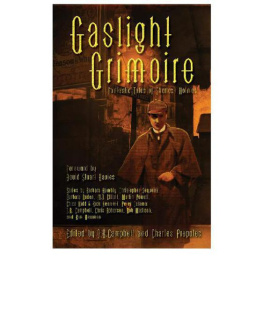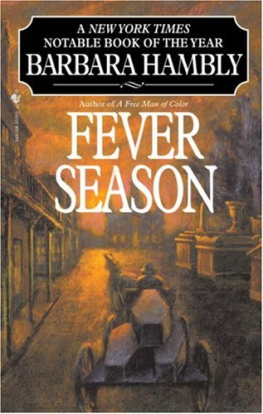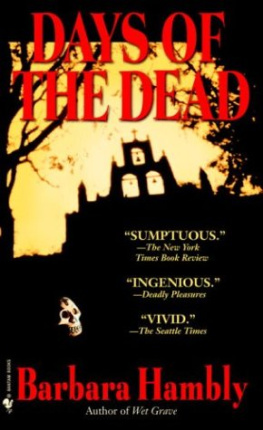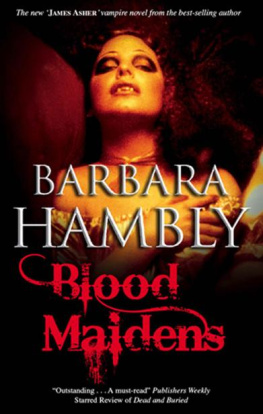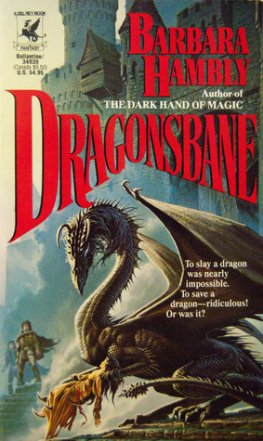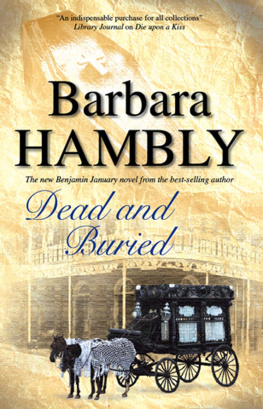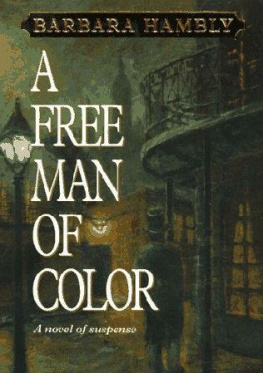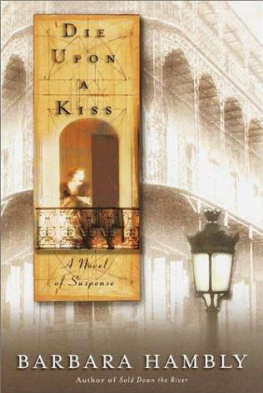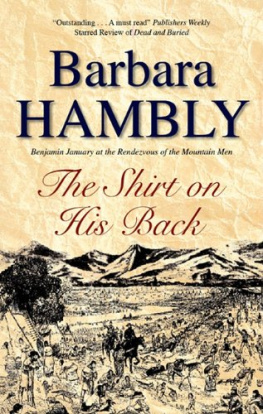Barbara Hambly - Graveyard Dust (Benjamin January, Book 3)
Here you can read online Barbara Hambly - Graveyard Dust (Benjamin January, Book 3) full text of the book (entire story) in english for free. Download pdf and epub, get meaning, cover and reviews about this ebook. year: 2000, publisher: Bantam Books, genre: Detective and thriller. Description of the work, (preface) as well as reviews are available. Best literature library LitArk.com created for fans of good reading and offers a wide selection of genres:
Romance novel
Science fiction
Adventure
Detective
Science
History
Home and family
Prose
Art
Politics
Computer
Non-fiction
Religion
Business
Children
Humor
Choose a favorite category and find really read worthwhile books. Enjoy immersion in the world of imagination, feel the emotions of the characters or learn something new for yourself, make an fascinating discovery.
- Book:Graveyard Dust (Benjamin January, Book 3)
- Author:
- Publisher:Bantam Books
- Genre:
- Year:2000
- Rating:3 / 5
- Favourites:Add to favourites
- Your mark:
- 60
- 1
- 2
- 3
- 4
- 5
Graveyard Dust (Benjamin January, Book 3): summary, description and annotation
We offer to read an annotation, description, summary or preface (depends on what the author of the book "Graveyard Dust (Benjamin January, Book 3)" wrote himself). If you haven't found the necessary information about the book — write in the comments, we will try to find it.
Graveyard Dust (Benjamin January, Book 3) — read online for free the complete book (whole text) full work
Below is the text of the book, divided by pages. System saving the place of the last page read, allows you to conveniently read the book "Graveyard Dust (Benjamin January, Book 3)" online for free, without having to search again every time where you left off. Put a bookmark, and you can go to the page where you finished reading at any time.
Font size:
Interval:
Bookmark:
Special thanks to those, in New Orleans and elsewhere, who have helped me with this book: to Paul Nevski of Le Monde Crole; to the staff of the Historic New Orleans Collection; to Tim Trahan of Animal Arts in New Orleans; to Priestess Miriam of the Voodoo Spirit Temple; to Greg Osborn of the New Orleans Public Library; to Adrian and Victoria; to Kate Miciak; to Diana Paxson; and always, to George.
Also by Barbara Hambly
A Free Man of Color
Fever Season
And coming soon
in hardcover from
Bantam Books:
SOLD DOWN THE RIVER
BARBARA HAMBLY attended the University of California and spent a year at the University of Bordeaux, France, obtaining a masters degree in medieval history. She has worked as both a teacher and a technical editor, but her first love has always been history. Ms. Hambly lives in Los Angeles with two Pekingese, a cat, and another writer. She has just completed the fourth Benjamin January novel, Sold Down the River.

VOODOO
As usual when writing against a historical background, it required an effort of will on my part not to wander off and write a book about voodoo. Like most religions, including Christianity, voodoo has been used and misused, criminalized and politicized, trivialized, glamorized, and sensationalized, used to manipulate peoples emotions and pick peoples pockets. None of this alters the fact that it was a lifeline of comfort for generations of people in pain. I have tried to write about it as it must have appeared to the people at the time of my story: blacks, whites, and the free colored who were a class and a culture separate from either.
Historically, voodoo evolved from the tribal religions of West Africa, a complex interlocking of ancestor worship, reverence for the spirits of nature, and an overarching belief in a single deity who works through the various spiritsthe loa or lwato aid humankind. The thousands of men and women who were kidnapped and enslaved by their tribal enemies, and sold to the whites, carried with them only what they had in their minds and in their hearts: skill at their trades, love of family, a rich heritage of music, and stories of animals and spirits. Among them were priests and herb doctors, priestesses and midwives, who carried the gods of their homeland, and the ways in which these gods might be petitioned for helpan invaluable treasure to people who needed help as desperately as any in the history of humankind.
As with most matters under slavery, how individual Africans or groups of Africans fared vis--vis religion depended largely on the personality and outlook of the individual white master. Many owners did not bother to convert their slaves to Christianity or were content with token baptism; others insisted on the show of belief. Given the brevity of the average slaves survival on a New World cane plantation, it may not have seemed worth the trouble. Anything that smacked of religious or any other organization among the slaves was, of course, severely punished, so the worship of the loaalways more or less a come-as-you-are, make-it-up-as-you-go-along proposition anywaywent underground, taking different forms, depending on where most of the slaves in any particular locale had come from and how strict a watch the local whites kept. It became a common practice to identify Christian saints with loa, either as a way to fool the whites while keeping integrity with ones own beliefs or out of instinctive syncretism, the belief that they really were the same entity by different names: like lenses of the same color, filtering the same Light.
In writing about voodoo in New Orleans in the middle 1830s, I have tried to extrapolate backward from the modern forms of voodoo found in Haiti and New Orleans. Even before the black revolution of 1804in which it played a significant partvoodoo in Haiti was enormously strong, and remains close to its original African elements. Spellings and names of the loa vary in different accounts: Spirits and gods from several different African cultures were incorporated and, at different places and different times, Native American spirits (or what second-generation Africans perceived to be Native American spirits) as well. In most cases I have simplified and have used the modern Haitian spellings, names, and identification of the loa.
Reading nineteenth- or early-twentieth-century accounts of New Orleans voodoofor the most part white finger-pointing at barbaric superstitionelements in common are clear: the priest and priestess (Hougan and Mambo, King and Queen), the worship of the serpent, animal sacrifice, dancing, possession by the loa in the course of the dance. Most agree that the loa like alcohol and tobaccoin fact, the loa like most of the things that people like: food, candy, bright colors, lights, pretty things, money, something to smoke. Voodoo altars are fantastic (and weirdly beautiful) accretions of whatever speaks to the worshiper of God or the gods, items dedicated to whichever loa is honored by that particular altar: Ezili likes certain types of perfume, the Gudthe dark loalike symbols of power and death. (Ive seen a black plastic statue of Darth Vader on one such altar, and its hard to see how that symbol of intergalactic power and evil could be considered out of place.)
Voodoo, both old and modern, is very much a religion of this world, of God or the gods acting in this world to help people attain success, health, help, or protection from a capricious and arbitrary universe.
Most accounts of New Orleans voodoo add that sexual excesses followed hard upon the dancing. This may be projection by whites who feared a more sexually liberated culture. But anyone who has gone to nightclubs and parties will be aware that the presence of loa is not required to connect the one with the other, particularly if this is the only time most of these people (a) get to see each other and (b) are able to enjoy a few hours in which they can forget theyre someone elses property and arent on call for some kind of work.
Voodoo has such an alien appearance to Westerners that, inevitably, it acquired an astonishing veneer of bizarre connotations. Nineteenth-century Christians regarded it as Devil worship (read nineteenth-century authors on the subject of the Buddhism of Chinese coolies working on the railroads and the Hinduism of most of the population of British India). Many French Creoles, brought up side by side with voodoo, went regularly to its practitioners for charms and gris-gris, something that would have deeply saddened their confessors but not surprised them. In the latter part of the century, half-understood practices coupled with the racism inherent in yellow journalism made voodoo a fertile source of sensationalistic plot elements in dime novels: zombies and voodoo dolls (and lets not forget those sexually degenerate dances) became staples of cheap thrillers, both printed and cinematic. HoodooAfrican-style sorcery and herbalismwas seen as part of the voodoo religion, although the closeness of the connection varied from place to place and from time to time.
In fact, the practice of voodoo varies even today. Some practitioners do it one way, some do it another, not to mention the plethora of tourist voodoo and of fakes and cheats to rip off the unwary and credulous. Even in Haiti, where voodoo is more or less an organized faith, it is a patchwork of personal interpretations of gods, rites, and emphasis.
All of the aboveand the fact that nobody attempted anything remotely resembling an organized and unprejudiced study of voodoo until almost a hundred years after my story takes placemake it extremely difficult to present a picture of what voodoo was, or must have been like, in the summer of 1834.
Font size:
Interval:
Bookmark:
Similar books «Graveyard Dust (Benjamin January, Book 3)»
Look at similar books to Graveyard Dust (Benjamin January, Book 3). We have selected literature similar in name and meaning in the hope of providing readers with more options to find new, interesting, not yet read works.
Discussion, reviews of the book Graveyard Dust (Benjamin January, Book 3) and just readers' own opinions. Leave your comments, write what you think about the work, its meaning or the main characters. Specify what exactly you liked and what you didn't like, and why you think so.


